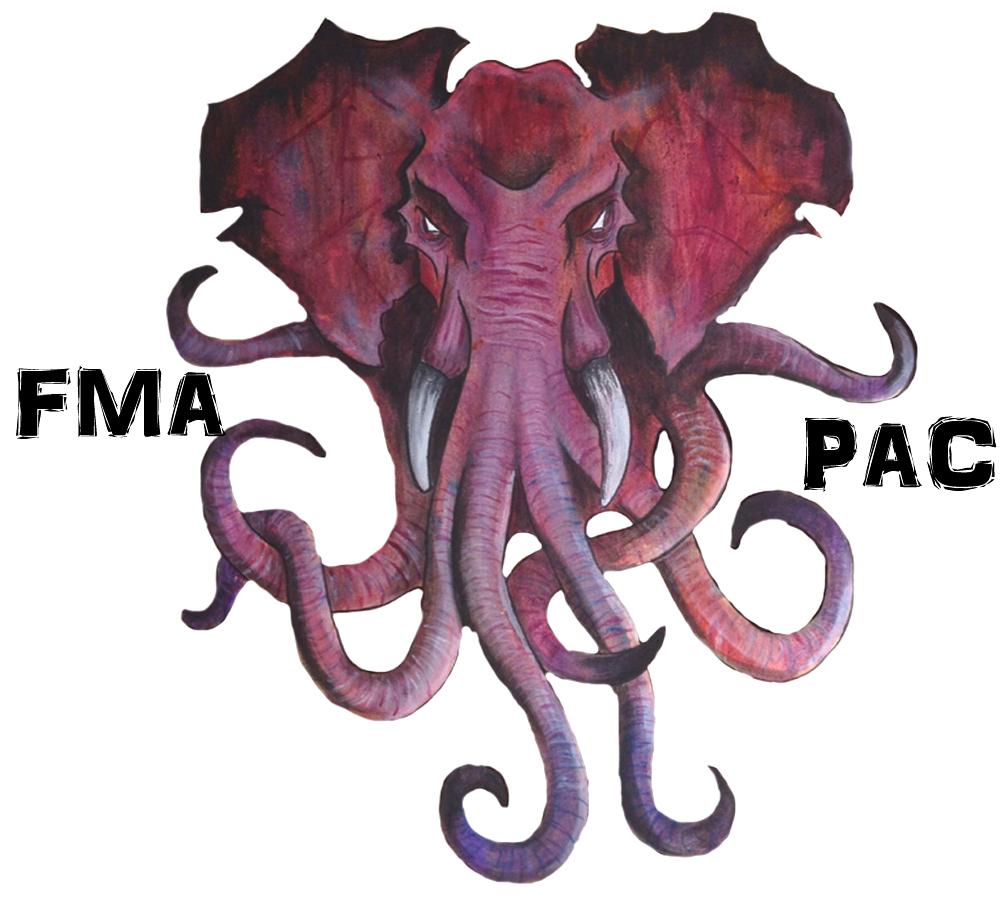



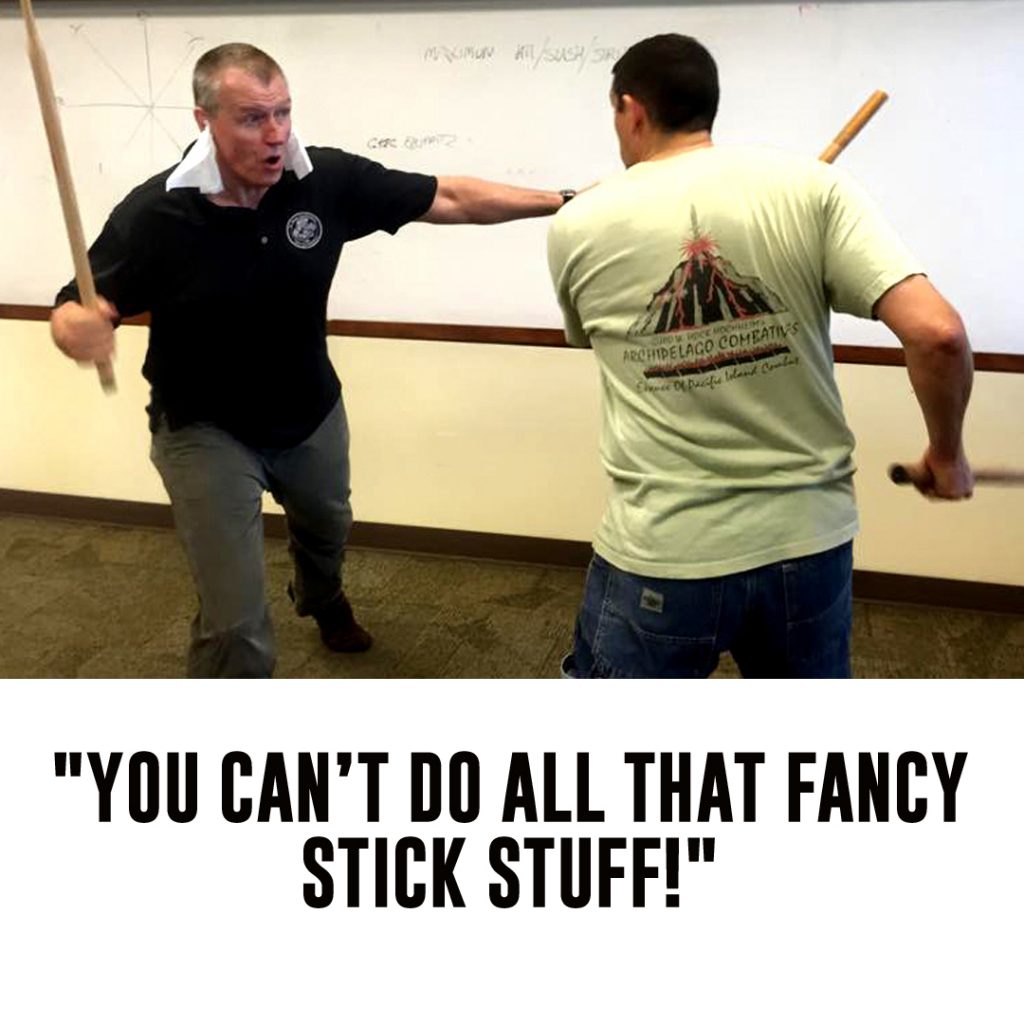 If you are a FMA “stick versus-stick-fighter,” I think, about…ohhh…80%…85% (?) of the stick material typical taught, thee so-called by many – “fancy stuff,” fancy follow-up stuff is meant for the seconds AFTER your opponent is busted in the head (no soft sticks and-or no helmets) or busted somewhere painfully vital, that will diminish his speed and brains. The head shot (or any real diminishing blow) is the missing link between sparring and the follow-ups.
If you are a FMA “stick versus-stick-fighter,” I think, about…ohhh…80%…85% (?) of the stick material typical taught, thee so-called by many – “fancy stuff,” fancy follow-up stuff is meant for the seconds AFTER your opponent is busted in the head (no soft sticks and-or no helmets) or busted somewhere painfully vital, that will diminish his speed and brains. The head shot (or any real diminishing blow) is the missing link between sparring and the follow-ups.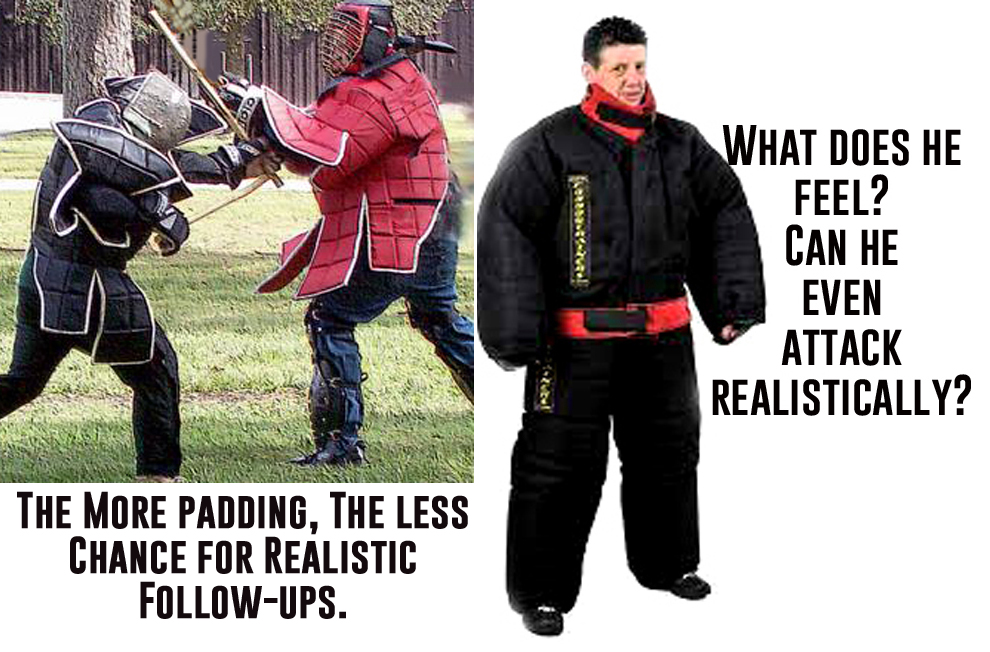
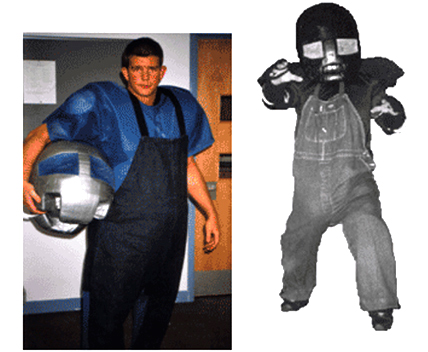
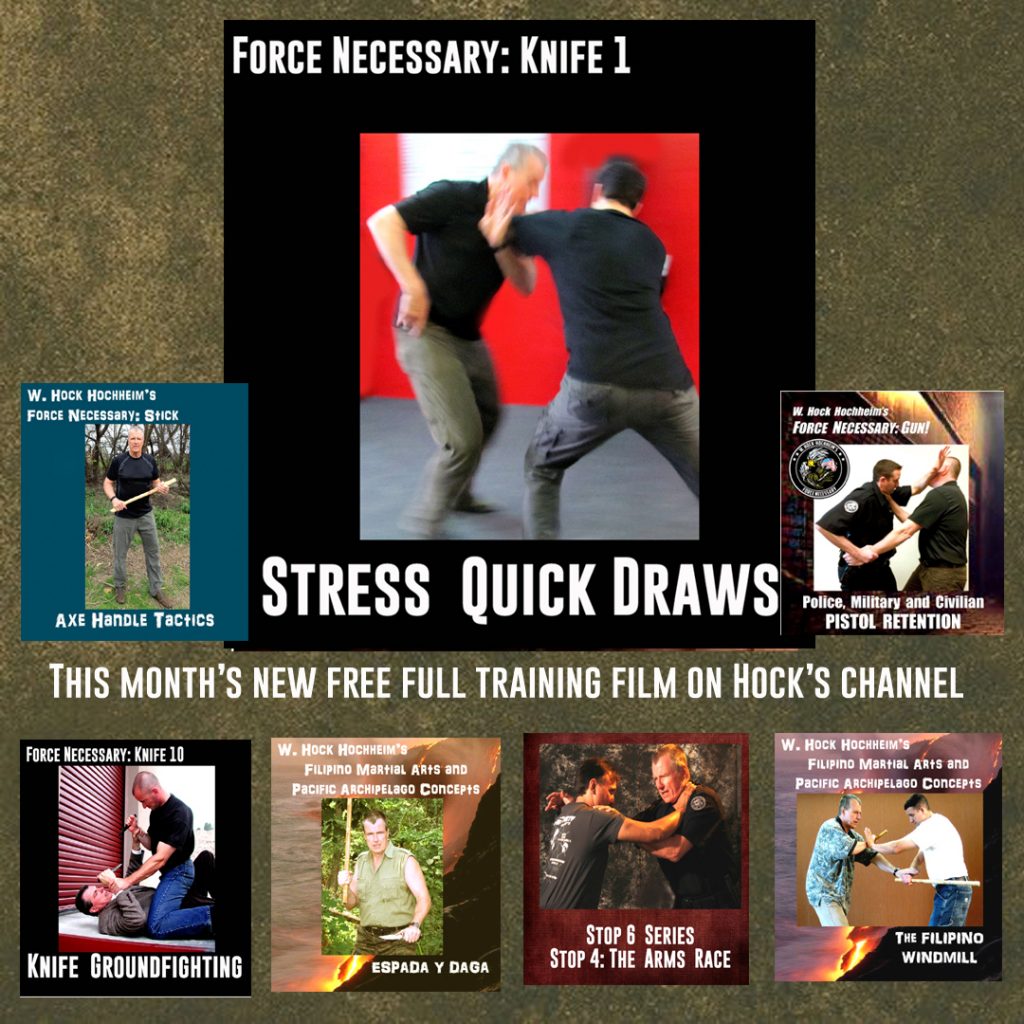
Every competent person, every competent organization has or should have a refined “mission statement.” It’s where you start. Like so many operations, and in a training company like mine, the mission statement is how you build and direct doctrine, avoid dogma, confusion and even hypocrisy. People-companies within their sphere must seriously define, the – “what we do.” One way to really help define what you do is to also seriously define what you won’t-don’t do.
Mission Statement Consequences? – Keep in mind, there will always be both good, planned consequences and unintended (bad?) consequences. Be flexible enough to make sense of things, changes and challenges.
In the 1990s, interested only in the generic, mixed-weapon world of hand, stick, knife and gun, self-defense survival (and enforcement-security), I decided to refine my Force Necessary mission statement to also explore what I don’t do, what I cannot make, and what I would not produce. This is a truth-and-honesty mission statement for me and for my “customers-practitioners.”
By simply understanding won’t you are not, you are not trying to limit yourself, you are trying to be realistic and stay…on a mission. The “no” reasons, the “why,” for each topic listed below might take a few lines, a paragraph or perhaps in some cases a book chapter to explain, but not a whole book to explain. But, no such details are pontificated here for a such a short essay as this.
A martial arts customer-practitioner needs a mission statement too and most NEVER-ever have. They just walk into schools like “dumb and dumber,” looking for things that the school doesn’t offer, that they saw in a movie last week. Revealing your different reality doesn’t always fit with the join-up, lobby sales-pitch.
Just in the teaching business with a school? Exist in that classic 5-square mile, demographic in a hunt for customers? You are at ground zero. As school-owners, don’t follow me and my “don’ts! Remember I have no school, my market is different, so don’t mimic me. Keep the kids and the uniforms and the dragon posters! Stay alive! And look, many people “change hats,” right within their diverse school. Then you should have a mission statement for your karate class, one for FMA or BJJ class and any other mission-hat-statement for your self defense class. I do want you to be happy and healthy, pursue your interests and hobbies and be successful. If you are happy? I am happy. But you still need appropriate mission statement…hats. It’s all a hat trick!
There is a not-so-old expression (and at my age I know what an “old” expression is) the new kids call – “staying in your lane.” What you are not, helps you understand what you are and helps you stay in your so-called “lane.” (This is true of life in general too.)
But for me exactly? If you are questing for the above traditional, sport and art goals, I can only quote Bob Dylan,
“It ain’t me babe, no, no, no, it ain’t me babe, it ain’t me your looking for babe…”
______________________________
Hock’s email is Hock@SurvivalCentrix.com
Watch free, long training films at Hock’s TV Channel, click here
In the big picture of fast and furious, speedy, adrenalized stick fight, where does the single stick disarm exist? How can it? Let’s take a look. An important way I think for starters, is to first examine the overall Filipino Martial Arts (FMA) subject of stick versus stick disarming. I identify really only FIVE stick vs. stick disarm categories…in the universe!
Thus far for me, all the disarms in the universe, the galaxy (!) fit well into one of these 5 general categories above. Impacts and lots of circles and push-pulls, huh? Which is another way to help teach and summarize-explain the subject. List the raw movement concepts within the 5 disarm categories. Here are the three raw movements inside all the disarms categories.
I have had the opportunity to dissect and teach this list of 5 disarm categories (and their 3 movements within) around the world for years now and some, even semi-famous FMA instructors refused to believe this 5-list rendered, simplicity.
“How can it all be that simple? NO! It can’t be,” they sometimes say, “well then, what about this one?” they ask and show a disarm.
“Well that’s a strip and keep because you caught and keep this stick,” I would say.
“Well then, what about this one?” Demo…
“I would say, strip and send because shipped the stick away.”
And so on and so on, the challenges were fun to explore and always help me refine, refine, refine.
Five categories. Three raw ways to do them. Simple? Complicated? Traditional disarms are often taught and passed on in disorganized ways, usually created by artistic people with no scientific sense or teaching-organizational skills (like so many nutty katas, huh!). As a student in various FMA systems since the 1986, I have seen many of these disjointed disarm lists that miss the opportunity for smooth education, conformity and simple understanding.
For example, many disarms are glued to traditional angles of attack system. “Guro Jose” has 10 angles? And he demands – “Do this different disarm at each angle. And here they are. Memorize!” Many traditional disarms are passed along by doing…say…one mandatory disarm at their angle 5, (6, or whatever angle), when actually an angle 5 attack might be disarmed by 3 or 4 different ways. Best to pick a disarm category first and experiment doing it against all 10 angles. It will work sometimes and then not. One might call that process reverse engineering? This is a way to make your own list. Self-discovery experimentation is great, recognized, retention method.
Anyway, a search for easy, relatable explanations and mental retention must be conducted. But for many FMA systems and instructors, simplicity was-is not their mission, and after all, complexity is the fun – wow factor- cool goal. That fun, wow stuff, and-or then the regurgitation of their historic art is more important than say…the simple, sheer freedom to fix and improve things.
After the list of disarms with the 5 categories, understanding how they are executed with the 3 raw movements, it was time-saving and thorough for me to make the next list of counters to disarms. (For me, the counter study was really related to thwarting the 3 movements. What universal things could be done to counter them?)
OKAY! Quick Disarm Tip: FMA stick is primarily a play within the Rectangle and-or “X’” box, and-or figure 8 circle, areas in front of your body betwixt the two opponents. Not as many training attacks come down from straight above, or up from low-low (there are a few more low than from straight down, still not enough). How did I determine this? Just examine your system and other system’s angles of attack drills to check this. One or maybe two angles of their 8, 10 or 12 angles comes straight down from above. The rest are side-to-side thrusts or slashes in that rectangle. In Guro Jose’s system, only one angle came down from above, the other 9 were other attacks. This means his system by innocent doctrine, de-emphasizes the common from 12 o’clock high, downward attack! One out of ten. On these high and low problems…

“Hock, connect sticks high? Then force the contact DOWN to the left or right sides where there are more and easier disarms. Low? Connect sticks low? Then force the contact UP to the right or left sides where there are more and easier disarms.” (Okay! Did Moses bring that tip down on another tablet we didn’t see? It was very helpful, conceptually.)
Okay, back to making your own list and using it in sparring. Free and eclectic. You got your list! Next, can they be done fast? Under pressure? The subject of this essay! We can all do them slow, sure. But so, in the big picture of fast stick fighting-sparring, how does the proverbial stick disarm exist? Can it exist? I know a lot of veteran hardcore stick fighters and they say they hardly ever saw a semi-elaborate move. It seems that in a full-blown stick fight-sparring (but with protection-see below), all semi-elaborate moves and elaborate moves are very hard to do and hard even to see-find in usual stick sparring.
In the same way we only see…ohhh, what? Eight, ten basic, non-elaborate, fundamentals in UFC fights, over and over again, and nothing elaborate seems to manifest, because the elaborate is usually hard to insert in the world of full speed and adrenaline. (I might add the impact disarm is probably the most common?)
I have found that in order to fully understand the possibilities of disarming in full action mode, I had to cut stick fighting-sparring into two categories and understand “stun, no-stun.”
Stun, No-Stun? Protective gear or not, you can do a few more things, go a little deeper in moves, be a little more “semi-elaborate” when an opponent is stunned-wounded. (Some come to you diminished, are naturally slow, untrained, etc. like their stunned!) If very stunned? Then elaborate! Sooo, protection matters!
So, single-stick sparring within the Stun, No-Stun universe:
Stick sparring with sturdy helmets and protective gear frequently ends in grounded wrestling matches because of the protection and limited, reality stun factor. Much FMA stick-duel instruction is given under this art-sport umbrella. Stick sparring without any such gear at all frequently ends in an ambulance.
Disarms! Who or what, where, when, how and why…are you? These questions define your training mission, your end goal. They create the important nuances of doctrine (and disarming). I surmise that that many practitioners think about all or any bit of these points and just play around in the art for the wow, the fun, the hobby. Wow! Which is absolutely fine, I only ask folks…just…know what they are doing who, what, where, when, how and why.
__________
Hock’s email is Hock@SurvivalCentrix.com
Check all the free Hock FMA training films, click here
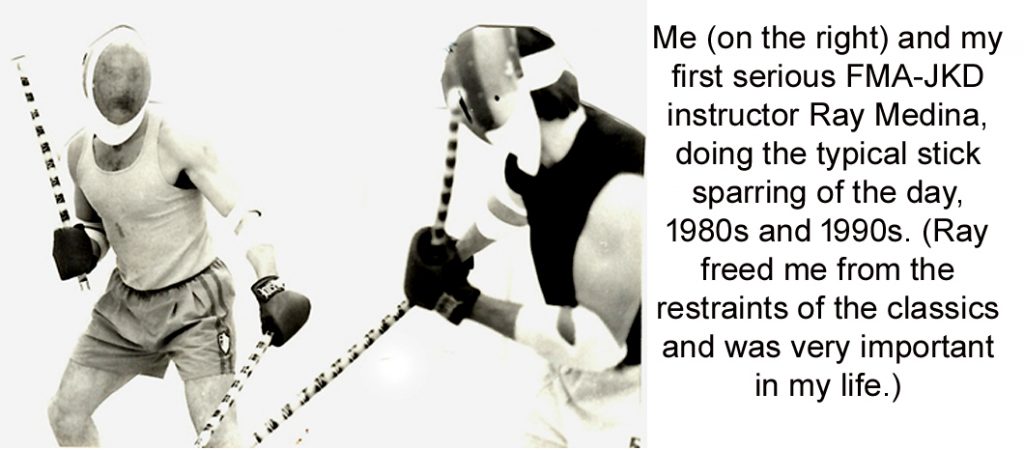 Respect the Head Shot? Do you? Really? One of the conundrums in FMA stick sparring is figuring out the realistic importance of the head shot and emphasizing it in a training doctrine. Ignoring the strike (as in “pretending” it didn’t happen and “sparring-on”) because you have a helmet on is training doctrine mistake. Making it “count” in a helmeted world is important and should be a mandatory training doctrine mission.
Respect the Head Shot? Do you? Really? One of the conundrums in FMA stick sparring is figuring out the realistic importance of the head shot and emphasizing it in a training doctrine. Ignoring the strike (as in “pretending” it didn’t happen and “sparring-on”) because you have a helmet on is training doctrine mistake. Making it “count” in a helmeted world is important and should be a mandatory training doctrine mission.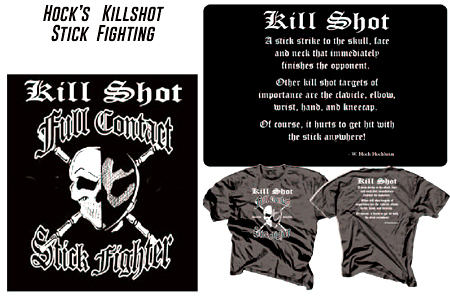

Okay folks. Bare with me. I have a few martial ranks through the years, (like a FMA, guro BB test in Manila). So, this is a joke but not a joke. I have a joke-meme I’ve passed around for years with two loaves of cut-open bread, a “white bread-brown bread” meme.
The idea is that “Joe Jones,” white boys will hardly ever achieve respected status in FMA. (I know a RARE few are, yes, yes, but most people look to and seek, foreign sources, certainly Filipino in FMA, but often settle for any American in the states with a “Spanish sounding” name. Or at least foreign sounding name. Exotic. Same is true for the rest of the planet. Think about it. Make a list and really think about it.
“The ‘hierba’ (grass) is always greener….”
And bland, white, Joe-Jones-Gringos (like me) take a back seat. This is not new, it’s a martial arts “universal.” Who wants to learn BJJ from a white boy from Finland? NO! Brazil! Or at least have a cool Hispanic or foreign surname! I’ll fall for that!
Eventually you will have to settle for a …”Gaijin” in your neighborhood. He or she may be fantastic, just not as well known, (and will remain unknown, which is actually the whole point of this essay).
All this is just the subliminal (and overt) marketing of life and what we seek out, like Chinese food, or Italian pizza and who makes makes the best cars? Germans or Japanese? Are ex-cons the best street fighters? Do the Israelis have the best military fighting system? Is Silicon valley the best source for all things tek? Why pick the Marines over the Army? People should recognize natural and man-made…”lures.” Who has the “best” story for what? And why? What then, catches our fancy? What do we gravitate to?
In fact, when I think about it, I have felt like a white boy (and-or wrong religion) outsider in most martial arts I’ve ever down, with all the real leaders always from elsewhere, Japan, Philippines, Indo, Russia, Israel, China, the sewers of Spain (gag)…the popular systems and arts are always from elsewhere. And me? Always the…gringo. This though I expected, it’s just an observation on martial life.
Anyway, there were numerous viewers of that “bread” meme on various pages, some very smart and substantial folks, and they laughed and liked it when I half-joked that I might therefore just call myself “El Gringo,” as part of an FMA business nickname, (I still teach FMA here and there around the world along with mostly combatives.) Just a fun, name-game and partly a bit of satire on all those grand, tuhon-guro-supremo-GM master titles that keep inching up like bamboo. For 26 years now, I just tell everyone I teach to call me “Hock” and remain on an equal, friendly footing as I believe system-head-worship is confining and not good for evolution. Bad for some of my business, but good for your evolution and freedom.
Some attendees-students still insist on titling me. It’s a tradition, you know. If you must call me something? Truth is, I’m just a gringo, a white boy, outsider from Texas who knows a few tricks of the trade. Tongue in cheek? A satire on the name-game? For FMA…call me…”EL GRINGO!”
“Out of the night, when the full moon is bright, comes the stickman known as Gringo. This bold renegade carves a “G” with his blade, a “G” that stands for Gringo.”
(Sung to the Zorro TV theme with apologies thereto. I realize the great young, unwashed has never heard the Zorro theme song. Never saw the old show. Too bad. Then feast! Feast on this video! https://www.youtube.com/watch?v=lQnle_3KuOE
________________________________________
Hock’s email is HockHochheim@ForceNecessary.com
Check out the PAC-Filipino page, click here
A Bigger Picture. In the martial arts world, stick versus stick fighting is most closely associated with the Filipino Martial Arts (FMA). A huge chunk of many FMA systems is indeed about the stick-versus-stick duels-events.
(Using-hitting a stick is an easy and fast training target, as with developing the smart fanning strike shown here – the abaniko. This is not necessarily learning how to stick duel, but rather learning to strike with a stick versus anybody with or without anything with a one-two-there fanning spin.)
To establish my opinion here, I remind that I have spent decades in FMA and decades in very generic combatives. Some people around the world think I am knowledgeable on the subjects, so here goes.
The best FMAs I’ve found spend equal amounts of time in what GM Ernesto Presas defined as “the 5 major areas of play” –
Equal time for the five? I find that some FMAs spend disproportionate amounts of time with sticks. Just look at all the group photos of FMA seminars. Everyone is always holding sticks. Sticks, sticks, sticks. Sticks have become the avatar for FMA. Sure it’s fine for some hobbyists, addictive even, whatever, but I “stick” with the Ernesto Presas “Big 5” format.
I am so often reminded of the classic Ernesto Presas quote, “The cane is the extension of the hand,” suggesting that the hand comes first. Dan Inosanto, so often pegged an a consummate FMA-er always does a plethora of other arts than being stick-centric. Too much stick gets FMA redefined to the “stick-only art.” It ain’t! It’s so much more.
Is this dueling calculus necessary in the real world? Through my decades of policing, training, cases and rather obsessive research, I have personally run across a few impact weapon “duel-related” battles like drunken, softball bat fights at tournaments, or crowbar versus tire iron fights. Things like that.
Stick dueling.Otherwise No. Almost all of us are highly unlikely to get into the proverbial 28” stick versus (coincidentally?) another 28” stick fight in a real world, dueling “street fight.” A study of the stick in common self defense should not-would not be centered around a mirror-image-fighter, stick-versus-stick dueling material. Secondly then, all this stick-trick trapping after longer range contact? No. Not this much. Obsessing with stick dueling and stick trapping should be relegated more into a category of fun, art, sport, hobby or exercise, with only abstract benefits to self defense.
While dueling helps various abstract attributes, there are indeed smarter things to do, to prep for a fight in crime and war. When you remove stick-versus-stick dueling and the calculus of stick trapping from FMA systems, there is so much less to worry about and train for survival. While It is vital to FMA, but even in FMA, there is always other stick things to work on like stick-versus hand, stick-versus-knife, even stick-versus-various, gun threats. Now we are looking like self defenders.
I am asked to teach FMA with some frequency and I do so with a great big smile as it is one of my fun interests, but I always make this quick lecture. As readers know by now, I preach the “mentality, hand, stick, knife, gun, mixed weapon, matrix.” And while my Force Necessary: Stick course must touch a bit on the impact weapon duel – because it has and can happen – in no way do I emphasize it. And a great many folks emphasizing self defense and combatives agree with me on this.
Watch out! These “reality” people are “window-peepers, peeping in your school windows, watching you on Youtube.” quick to judge what you are doing and pigeon-hole you as artsy and off-mission Arnis versus reality. Which leads me to the name-tagging quandary.
For self defense combatives, the trainer and trainee, the work-out partners should still both often hold sticks sometimes. Sometimes? In stick training, it is much easier and faster for both partners to hold sticks for various goals. You do, I do, You do, I do. Ease, target practice and stick blocking to name three.
(Target practice! And you can hit hard. He can learn to block well too In the FMA world other Arnis-Kali things happen.)
So even if you are a self defense, combatives person you might find yourself looking like an FMA-er when both the trainer and trainee hold sticks and appear to be doing “too much stick versus stick” to these short-term window peeper-complainers. But still, dueling is not your real, end mission.
In summary, a few quandary warnings to think about…
Obviously I use an impact weapon emphasis in my Force Necessary: Stick course (details listed below, the self defense, stick matrix,) but I do not overdue the stick versus stick aspect when covering that course. FN Stick looks like this:
When teaching FMA I try to do everything but in equal proportions.
Hock’s email is Hock@HocksCQC.com
_____________________________________________________
Get the Impact Weapon Combatives book, (the new second edition!) Click here
HANDS-LANDS – Touching the “hands” of the master. Touching the “lands” of the master. Hands-Lands.
(This was a spirited discussion on FMA Discussions. Many say you MUST go to Philippines to “get it.” Many say no. Not needed. I said…)
I started attending Remy Presas seminars in 1986 and I was just another person in the crowd. One attendee was also an Ernesto Presas guy who asked me if I knew Ernesto. I did not and he pulled me aside into a curtained-off meeting room from the big seminar. Two others were there too and we started doing Ernesto stuff. This guy trained me in Ernesto’s material for years, which is different than Remy’s. Four or five years later we wound up in the Philippines. Once back in the USA, at the next Remy seminar, attendees told Remy I was over there for three weeks and even stayed at his old Negros house, etc. He liked this, called me over and wanted family gossip and so forth and only then did we made the solid connection, because he knew I was THAT committed to go over there. I started hosting Remy for years, etc.
Later at a Remy-Dallas seminar at Steve Selby’s school, Remy made a speech about training and with whom and “Touch hands with the master,” or as he would say it, “Touch hans’ TO de’ master.” He pointed to me and said, “Hock has gone twice to de’ Philippines already. I don’t know why? Because…I am here!” Everyone laughed as did I, shaking my head. You could tell by his smile that he making a joke. But why go?
The pro-go Filipinos in the FMA Discussion seem to want you to see the lands, walk barefoot on grounds, breathe the air, eat the food, dive deep in the history otherwise you won’t really “get it.” Like live there? “Going native” – is “to adopt the lifestyle or outlook of local inhabitants. Furthermore, must we also “go native” with all these martial arts we take? While Bruce Lee said all these things were just “Kicks and punches,” must we go down a national rabbit hole and become Colonel Kurtz? I went a little native in South Korea. Lived in the village, etc, but didn’t become a Kurtz. The military grants you time and grade in obscure locations, otherwise you are in-and-out tourists.
Tourists. I often look at folks traveling to the homelands of their martial arts. So many go to Okinawa, Tokyo. South Korea. A friend of mine even went to NORTH Korea for a Tae Kwon Do pilgrimage! (He said it was scary.) All serious Thai Boxers go to Thailand (although in my “heyday-times” of Thai -1990s- many also went to Scandinavian countries for Thai). I think it’s a pilgrimage some want to take. I think it is situational and circumstantial. After my P.I. trips, we got Ernesto coming over the states with gigs and the P.I. trips were long and expensive for me (and my job). The circumstances, the situation, the need was over. But I will confess, me having “gone over” several times was a big marketing help for me.
People like to travel and touch for really unique reasons, lest of all over martial arts. I have a good friend in England who worships the Spaghetti Westerns of Clint Eastwood. He and his wife visited the small town village in Tabernas Desert and the Cabo de Gata-Níjar Natural Park in Spain where they were filmed. He has small glass jars of the sand from there as souvenirs. The human drive to visit.
Look at all the people running to Israeli for religion and Krav! The Japanese see Americans going over and dressing like they are ninjas and they laugh. One Japanese-American told me it would be like Japanese coming to America and dressing up in Civil War clothes and taking part is a Civil War recreation. WHY!?
I like for people to be happy and if they want to go, and afford their journeys if they can and should go. I would like to go to Frank Sinatra’s house in Palm Springs. I might not get a glass jar full of booze, but I would like to sing a song there in the backyard.
What of the name-game and FMA? This is actually a whole other FMA discussion subject, somewhat related though, but the real success stories in FMA, those with sought-after instruction and with bigger groups are really all Filipino people. Or they have a name-game-stretch-connection, with Spanish or exotic sounding names yet have never gone to motherlands. Dan Inosanto, a real important FMA pioneer, has never been to the Philippines that I recall. How many land-locked, Americans just have exotic foreign names and have large groups? (They could be good or bad but still get the immediate attention.)
Even though I have been over there – this is why I do not flash myself around as some kind of special super-duper, FMA Person. I will never be an FMA real deal. I am happy to help others get an understanding, etc, if they are interested, but I am just a white boy in Texas. I can only think of a very few white boys with consistent, international FMA success, oh like Bill McGrath and Deiter Knuttel from Germany. Otherwise you gotta’ be Filipino or have a Spanish sounding name and,or seem to be Filipino or could be Filipino. Or else, you better be seriously attached to one. The truth (skill) bears out later.
Origins and names…this is a universal, martial idea-draw. As a parallel, looking at ads and videos would you want to take Brazilian Jujitsu from a Tim Smith? Or a Jose Gonzalez? Who has the immediate advantage? Most would instinctively go with the Jose. (Makes me think, speaking of other parallels – how many Yankees are going down to Brazil to learn BJJ, to go “native” in that native homeland, or have all the experts moved up North?).
On “Going native,” furthermore, must we also “go native” with all these martial arts we take? I do think back through the years of Systema people getting so wrapped up in it that they started becoming communist. Posting pictures of Putin and remarking in pro Russia statements. How some Silat people became Muslim? And then even radical Muslim. I’ve seen it. Krav people becoming Jewish. Like Bruce Lee said – all these things were just, “Kicks and punches,” must we go down a native rabbit hole and become Colonel Kurtz? Studying how to kick and punch should not ordinarily alter your politics and religion.
Touching the “hands” of the master. Touching the “lands” of the master. Hands-Lands.
__________
Hocks email is HockHochheim@ForceNecessary.com
Don’t let this photo scare you! Click here and check out the PAC-FMA streaming videos
#marlonbrando #apocolypsenow #franksinatra #spaghettiwestern
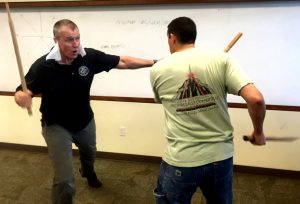
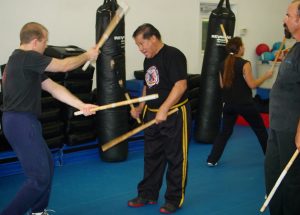
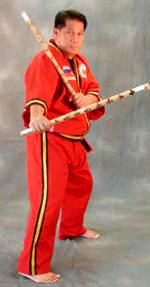
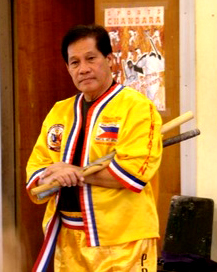
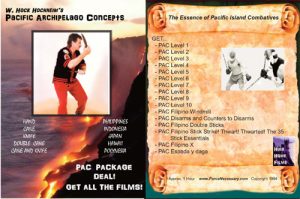
I was thinking about the classic park in Manila. “Rizal Park, also known as Luneta Park or simply Luneta, is a historical urban park in the Philippines. Formerly known as Bagumbayan in the era of colonialism under the Spaniards.”
For many a decade if you trained in Manila, the Philippines, a must go-to place is this park. Many, many famous people have taught and gathered here. And when we were in Manila, we were either at the Presas school, this park or at the college where Ernesto taught Arnis at those times.
It did bother Ernesto a bit at times at the park, because various FMA grandmasters would set up folding chairs and watch us. He would whisper, “You see dese guys? Dey are grandmasters. Dey are spying on me.”
This above photo is me and Shelley. Early 90s. There were only like 6 of us there, so it was pretty intense. Under his scrutiny all the time. We would go about 4 hours in the morning and about 3 1/2 hours in, there would be a break. Ernesto would say, “Take a break, then…examination time.”
This photo – Since we were so few, we also had his black belts as partners too, who were very helpful too. With Renato “Boks” Centro.
“Examination time?” we’d say in the beginning days. He was always “testing” us, but this would be a more real test for the last part of 3-4 hours. So…there was no break. We would walk off behind some trees or bushes and work through those ten minutes to hurry-review what we did. Then some water.
Then…the
“Come on, COME ON!”
“Speed motion!”
…observation “test.
Then lunch. Then another 4 hours. 6 days on. 1 day off pace.
That top photo again. Me, Shelley Millspaugh and the big man GM watching us. Captain Rene, a Honduran fighter pilot is behind us. Shelley Millspaugh added: “Great memories. That first camp was as intense as you could’ve made it. I haven’t had that type of intensity since. GGM was the Energizer bunny. Never stops.”
++++++++++++++++++++++++
Hock’s email is HockHochheim@ForceNecessary.com
Remy Presas frequently told this story in seminars. Many of us have heard this “leff story.”
After witnessing several bolo (machete fights) which I chronicled earlier on the Presas Group Page) , and after the somewhat underground “sport” of bolo fights began to disappear from deaths and maimings, rounded sticks replaced the bolos in fighting for money. (Not sticks shaped liked swords but rounded ones – something else I wrote about on the Presas page.) Remy fought these fights for money in boxing rings, cockfight arenas and wherever betting groups might gather. He told us that after a while, numerous people approached him to teach them and their sons how to stick fight.
“But I am leff,” he told them. Left-handed. “And dey were right.” He said he could not teach them. They pushed the requests.
“But de money became so good…I become right.” He started to teach them the stick with his right hand. Much of it was longer range stick dueling (“of course, you could just hit de man in de head with a stick.” – he would often say, when discussing complicated moves.)
And as Remy has said often, the double sticks help teach the “other side” anyway.
In short, really short – lefty versus righty has always been a big thing in sports. The southpaw boxer. The lefty pitcher versus the righty hitter in baseball. Lefties are 1 in 10 people. This is an advantage for them simply because most sports folks and fighters have built up a “versus righty” repertoire, a library in their head, even like in their “subconscious” of what tiny steps and moves a righty does to hit, kick and position them. The most subtle increments are stored in the brain. We use them as tip-offs. We see less of these reps from a lefty, as there are less lefties.
“I become right. I become good.”
And he made a lot of money teaching righties. But still fighting too. (and he had a few jobs too. Working at a family shipyard and…not known by many, a barber.)
He would say in seminars about the money stick fights…
“Round one, I am right.
– Ding.
Round two, I am right.
– Ding.
Round three…I am leff. I win!”
His eyebrows would raise. We all would laugh. We got it.
Remy became as ambidextrous as possible. In close quarters, he could switch hands effortlessly and really foul up your brains. He taught this inside the newer tapi tapi. He taught this on the single stick versus double stick drills, as you must go single stick right and left-handed versus the double sticks. (Ernesto did this too.) These were Presas “leff” priorities which I can’t say I found “up front” in many other FMA systems.
(I remember one Inosanto seminar many, many years ago in Irving, Texas where, for about 2 or 3 hours on a Sunday, we did left-hand sumbrada. It freaked all the experts out. We became bumbling idiots)
“You must do boff leff and right!” – Remy Presas
+++++++++++
Hock’s email is HockHochheim@forcenecessary.com
Join this Facebook Presas memory page, click here
.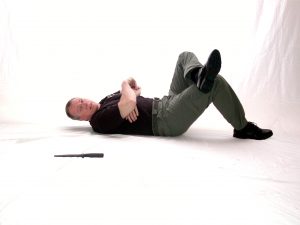
I know the depressing, dark side, the wet side in juxtaposition to all the smiling people having fun, slap-dashing around in gyms playing tag with wooden and rubber knives. Knife training is often treated quite cavalierly. This doesn’t have to be the case as very serious cultures exist, like the culture of pistol training is quite serious and full of foreboding and legal scares. Careful, mature training cultures do exist, and this must certainly become true in knife training also.
In the early 90s, this edged weapon resurgence was sort of an international turning point in knife training. A reboot if you will? It first resurrected the old military knife courses and the semi-legendary names of yesteryear. They weren’t “kuraty” superstars. A sophisticated look at them however, revealed, they weren’t so sophisticated. So several of us, using the newer sports training methods of the time, and bolstered by years in Filipino martial arts or other historical backgrounds, stepped up and made “new” knife courses. Gone was the martial arts uniforms, belts, etc. We wore jeans with pockets and regular clothing belts. Street clothes.
Some of the 90s knife pioneers? James Keating. Tom Sotis. Kelly Worden, Bram Frank, Bob Kasper, yours truly, to name just a few, but there really were only a few of us. Paul Vunak is a late 80s pioneer in many areas. (Still, some of these guys were overdosing on knife dueling.) We wore shirts, jeans and shoes. I even taught at times in a suit and tie. Skeptical, we didn’t trust the old stuff and we didn’t trust the established martial arts either, even the Filipino applications of the knife are often tricky and too “duely”. (Do you want to walk around wearing a vest with 12 knives? Seriously.) Be free. Think free. Be skeptical. Are you a replicator? Or an innovator?
Still, the old just helps the new. This was also part of a bigger “breakaway” from establishments that was going on in that decade. The world was seeing MMA (or at least ground wrestling) on TV like never before. And somehow a collection of old stuff, dressed in athletic pants, painted in the “Israeli mystique” – Krav Maga – was really shoved down the throats of Tae Kwon Do schools as mandatory, by clever (and insidious) shaming, business groups, like NAPA in the 90s.
The “Mixed Revolution” was in the 1990s martial air! Jeet Kune Do was spreading into a heyday. Inosanto JKD/MMA was already doing Thai and ground, and so much more. Ever hear of “Shoot?” But, I guess the Israeli mystique was greater than the Bruce Lee mystique?
Mystique? Yes. Ever so important in advertising, sales and manipulation. That’s how we pick shoes, cars, purses and pistols (politicians, religions and…) Manipulation. More on that later…
My knife course had a few odd, infancy names in 1990 and 1991, but it was quickly called “When Necessary? Force Necessary: Knife!” But that 5-word title was a little long and clunky and it was shortened to just 3 words – “Force Necessary: Knife!” I do prefer the longer, clunky name, as it completely explains exactly what I mean to say. Only use that force necessary when absolutely necessary. But I got around the country and quickly, the whole world doing that knife material. Lots of traveling, lots of seminars. It lead to being voted Black Belt Magazine, Weapon Instructor of the Year and also into their BB Hall of Fame. (back when readers actually mailed in votes.) I also “scored-very well” in the non-arts, growing “combatives” world.
Black Belt. Tact Knifes. Hall of Fames. TRS. Such was the jargon and the martial/political stage of the 90s. Today, it’s hard to grasp that the total, martial world communication back that existed was with a mere 6 or 8 international, martial arts magazines. That’s it! Try and list them. Yes, Black Belt, Blitz, Martial Arts Illustrated, Inside Kung Fu, Inside Karate. Think of some more. Try and list them. They were the filter for us all. Talk forums developed slowly later and now, like the magazines, are almost all extinct.
Now? Nowadays, I don’t know where the martial arts communication filter exists, specifically. The…web…the gazillions of webpages? The gazillions of podcasts? The gazillion of….Instagrams? Facebook? Yesterday’s business card is today’s webpage. And any dipshit can pay to have amazing looking webpages. The battle for exposure takes a business up and down many extremely, frustrating, costly roads.
Of course with all businesses, this 1990s knife movement kicked off a new interest and a fair number of new knife courses popped up through and to, by 2005-ish, often by less experienced, less organized people, and in my opinion doing less comprehensive programs. But this business evolution is to be expected. Invent a new “widget?” There’s a knock-off. Then knock-offs with an “S.” In the big picture of training and education however, not widgets, this can be a positive thing. Awareness. Curiosity. Growth.
So, when did I fall? It happened slowly and then one day you are down looking up. How’d I get down here? Not enough Instagram pictures? Some 25-odd years later, in about 2015, on a popular public forum someone asked me what I thought of Johnny Swift’s new, knife, quick-draw article. Of course it was named something super-spiffy like “Armageddon Instrument Production,” but it’s just knife quick draws. Brand new, Biblical-worthy advice Swift preached, and published in the new amazing world of web-jargon magazines called something like “Organic Micro Evolution of Edged Prophetic Dynasty.” (I just made that magazine name up, but how far am I off? Have you seen these seminars names lately? Aren’t you impressed, or can you see right through the pretentiousness?) Twenty and 30 year-olds salivated!
I read Swift’s ground-breaking, testament as featured in “Retrograde, Skill Supremacy, Fusion Elite Magazine” and I replied on the public forum –
“Oh, I have to like Swift’s article. It is virtually, word-for-word,
from my 1992, Knife Level 1 outline.”
My review/remark caused a lot of guffaws and a few smart ass remarks, among the 20 and 30 year old readers, most of whom were so submerged in modern “dynasty jargon” and up to their beards in mystique, and lost in the gazillion web world, they’d never even heard of us older guys from the 90s. I mean, who am I to comment like this on their latest fad-boy genius? I added that I was not suggesting that Johnny Swift plagiarized my outline, as it might have innocently been co-opted, or the older info has become so, ever so embedded into the “knife world” it was deemed as open knowledge. I get that. Sure. That happens. (That level 1 outline is/was free to the public and has been distributed for literally 3 decades, and my knife books have been for sale since about then too.)
I reminded the guffawers that the spread of education is a good thing and that at very least, I only partook in that process. I said that the old just helps the new, and you have to remember the old, so history doesn’t repeat itself. As a great gun instructor Dave Spaulding likes to remind us, “It’s not new. It’s just new to you.”
One guy was clever enough to say, “Well, sorry I missed you when I was 5 years old.” Ha! I told him that was a pretty damn, funny retort. It was. But missed me? Dude, I never left. But actually he never knew I was around to begin with. That is part of the mysterious “fall.”
I added in that discussion with Mr. Wise-ass that the spread of education was a good thing, and I only partook in the process. Seriously, I frequently read as new, many old catchy terms, ideas, expressions I published and advertised decades ago.
My really big mistake in the knife world, training business is…I think, not emphasizing the knife training course only. Alone. My obsession was/is with covering the bigger picture. Hand, stick, knife, gun. That’s “where it’s at” for me (is that phrase too 90s? Yikes, maybe too beatnik 60s?). The 1990s evolved into the 2000s and my step-by-step into what I really wanted to do all along since the 90s. My goal is to create the best hand, stick, knife and gun courses. It’s a mixed weapon world. Each subject I have is a carefully constructed 4-pillar, foundation. But I think when you shoot for this holistic picture, each separate pillar seems to get a little lost, a little less appreciated, a little less noticed. It also makes me appear to be less specialized. This ain’t true. There’s a big mixed weapon matrix:
But anyway, back to the knife! Inside a comprehensive knife course is:
I do get a kick out of the occasional lame-brain who pipes up and says, “Knife training? Just stick the pointy end in the other guy.” Especially when these same complainers spend about ten thousand $$$ a year – plus – shooting at gun ranges. Why not just stick the pointy end of the bullet in the other guy, too, Brainiac? Is it all really that simple?
But, not focusing just on the knife is a marketing problem. I don’t advertise or highlight “just the knife” like other courses do. This is one point where I have really fallen down and why my knife course has fallen down through the years.
Another problem for me? No “flags.” I have no crutch system, no flag to fly, like Pekiti, JKD, Brazil-Mania, Krav. Silat. Arnis. Bruce Lee. UFC. It’s just little ol’ me flapping in the wind. I can’t draw in extraneous-system-people, capture super search terms, as some of those are obligated to attend, even arm-twisted by “the system” they’re in. Brand names are…brand names.
Plus, I avoid and dodge macho, death messages, grim reapers, and death images mystique. I would never advertise that I am “always bladed.” And I am not in any “mafia.” I am life-long cop. I fight the Mafia. I am not in any “cartel,” or a “cult” etc. Look, I can make the distinction between something that is a little fun and ironic and something/someone that is sick and weird. It takes a little investigation too, to not jump to conclusions, but sick and weird is sick and weird.
Various other ultra-violent, whack-job messaging should be reserved as a primer mentality for very serious, military, combat groups. THEIR psychology. Their prep. Not cops and certainly not every day, walk-around citizens. Mimicking them makes you look like a wannabe punk. Look at the lawsuits filed on cops and citizens. Go ahead, have a little death-engraved-logo on your cop gun and see what happens when you shoot someone. Have a patch or tattoo of a grim reaper with a knife, or a skull with a knife through it, and see what happens when you have to use a knife. We the police, the prosecutors search your history when you are in an assault, knifing or shooting. Mature survival is enduring the end game – as in the legal aftermath, is a big part of a well-thought-out, course. (Again, mature gun easily people understand this.)
Not like this silly fucker in New York for example – I read one New York City, very popular, international knife “cartel-liberty” group headline paragraph:
“I love it when I carve someone’s balls off and put them in his empty eye sockets.”
Shit man, you probably work in a fucking supermarket. And you think and talk like this? You need to be on watch list. These idiots give us all a bad name. But images and expressions like this, or near like this, this mystique, does attract a certain sick customer, usually young, or young in the brains anyway. (After my public complaints and comments on this, this moron took that line down.)
No Mystique? Which leads me back to the first paragraph. We know the established advertising fact the “the grass is always greener on the other….” side of the street? Other country? The sewers of Spain. The temples of Thailand. The monasteries of China? The borders of Israel…the…and so on. Me? I appear to be just a bland, white guy with some info. I don’t even have any tattoos! Many well-known knife people are Filipino, just cause, because…they are Filipino. They may have never been to the Philippines, but they have an exotic sounding name.
And the serious military angle? Even with them, take a look at the most sophisticated, revered, respected, top-flight, Special Forces vets and most play it quiet cool like a gray man.
Lackadaisical about making rank and instructors. I don’t really run the classic franchise business as seen in self defense, BJJ and Krav, other combatives courses, and Lord knows, classic martial arts. I am often lackadaisical about promoting people and making instructors. Other systems do this like precision clockwork, where I fail to emphasize this. It does hurt the proverbial martial, business model.
In the same vein, I shun all titles like guro, grandmaster, sensei, etc. “It’s just Hock,” I say, which also does not fly well with some organizations who base themselves on this structure. Also, street clothes please. It’s almost like I am insulting them? I’m not trying to. You do whatever you need to do to survive.
After the fall. However boring, I still do see some “knife people” all around the world. There are “normal” people, martial artists, historians, survivalists and hobbyists, gun people out there, interested in generic, evolved, knife material. There are. And that is who I mostly see when the knife topic comes around. Since I disdain the crazies and the fringers, they usually avoid me too. I know they know, I don’t like them.
I always do a few hours of knife in every seminar and I do have the occasional knife weekend seminars when and where I realize I need to catch up with people’s rank requests. And, normal people can always, sort of, hide their knife interests inside a classic martial arts name. To me the knife is inside of, part and parcel of, hand, stick, knife, gun crime and war, survival education.
So, me. Boring. No mystique. Not isolating the knife enough. Not promoting people fast enough. No skulls. No flags. No carved out-eyeballs. No macho. Just generic methods. Here is where I have shot myself in the…well, stabbed myself in the foot, in the knife training business, even though just a few of us are those innovator pioneers and turned the tide in the 1990s into what it all has become today. For better or for worse. Maybe you young fellers will learn from my mistakes?
It’s always good to mention and/or thank your prior teachers once in a while. I always do. But, before you young knife guys make any sarcastic jokes about me again (and Kelly and Bram, et al?) Keep in mind…your modern instructors might have “peeked” at all my and our long, established materials, and would not confess to it. I might just be your grandfather. Our materials have become such standard doctrine that these young guys don’t even know of us.
++++++++++++++++++++++++++
Hock’s email is HockHochheim@ForceNecessary.com
Get what is still called the greatest knife book ever, 1000s of how-to photos in the topics above, click right here. (Now in a second updates edition.)
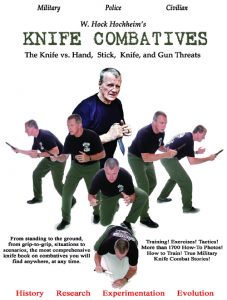
The Equal Opportunity Stabber. Saber or Reverse Grip?
I am an “equal opportunity stabber.” Sound weird? Hear me out. I’ve heard the knife whisper. Have you? About the secret “best grip tip.” You know the one, “If you see a guy hold a knife like this (reverse grip) watch out! He really knows what he is doing.”
Now for the novice reading this, real quick, the saber grip is the most popular nickname for holding the knife like a sword with the blade sticking out the top of the hand. The reverse of that, the reverse grip has the knife blade sticking out the bottom of the hand. Both are quite natural grabs. New or experienced, young, old, whatever, the knife is a great equalizer and both can deliver bloody devastation.
Ahhh, but “the reverse grip is best,” so whisper the tipsters who know nothing, learned from yet another tipster who knew nothing. I have heard that “insider reverse grip tip” numerous times through the years. One example-
“I was at a seminar once where an “expert” told us that if we see a man using a knife in that grip to “Run! That man is a professional!” – Carl Flume (So you don’t run if the robber has a saber grip?)
I have nothing against the reverse grip. I teach it too. But, how many times have you heard or been told, or taught the reverse grip is the only grip to use? Because there were and are some popular courses out there preaching this idea. Mindless followers will whisper and argue that:
People! People….people. FMA does BOTH grips. Pekiti Tirsia also teaches tons of saber grip material. And Pete Smith? He is just, flat-out, wrong-headed about this. He is not as smart as you think. He’s not as smart as he thinks. The whisperer? Let’s explore that now.
Knife Confusion. I am often both depressed and fascinated by the paths, choices and ideas of various knife courses. Some obsess about dueling. Some appear to me like death cults, others have what seems to be oddball, incomplete conclusions. Most never cover legal issues and just cut and stab away. No knife ground fighting. No knife versus unarmed or mixed weapons. Some way over-emphasize Filipino Sumbrada patterns. Some have only three or four stabs with zero concerns about the before during and after, the old “just sticking the “pointy end” in. How about those little rounded-handle knives that can turn easily in your hand? I could go on. Another, probably big dichotomy is this grip thing and the various obsessions with the one, bestus’, mandatory, knife grip.
In the 1980s, I was at a Dan Inosanto seminar and Dan said. “there is no one perfect knife grip, just the best one for the moment.” Wow! That little phrase stuck with me forever as a baseline. With my Force Necessary: Knife course, I insist that a practitioner learn and experience BOTH the saber and reverse grips standing through ground, right and left handed. Then after much COMPLETE study, they choose what their favorite grip is, based on the “who, what, where, when and how and why” of situations and their lives. I never tell them to automatically favor any one grip. Make it an EDUCATED choice (and not follow a whisper tip).
How Favoritism Gets Started? Here’s one example. The first time I received any training with a knife was in a Parker Kenpo class in about 1972 when that day they received a package of Kenpo knives and dull trainers from Gil Hibben. The knife was designed to be held in a reverse grip and used in a kickboxing format. There, me as a yellow belt rookie, we were allowed to fool around with the newly arrived tools. This initiation, this design I think caused decades of Kenpo-ists to hold their knives in a reverse grip as though Moses, not Gil Hibbens, had handed them knives from the mountaintop.
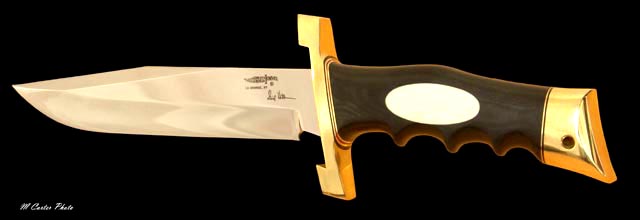
In the late 1990s I was teaching in a multi-instructor camp and a old Parker Kenpo black belt was there with his imported group. I was covering saber grip material and he would horde his people over into a corner after each demo and show them the “proper, reverse grip way” to fix what I was doing saber style. Which by the way his was more complicated and somewhat awkward than the simple saber applications I was covering.
Finally he just had to approach me and said, “you know, the reverse grip is the superior grip.” I said, “No it isn’t.” He glared at me. I added, “You can do just as much or even more with a saber grip, often simpler, with more reach.”
Well, he stormed off – his 7th dan “master” self, all upset that someone younger in blue jeans and a polo shirt told him flat-out, no. (Oh, did I mention that he also makes and sells reverse-grip-only knives?) My next session by the way, I covered some reverse grip material, as I am…as I said…an equal opportunity stabber.
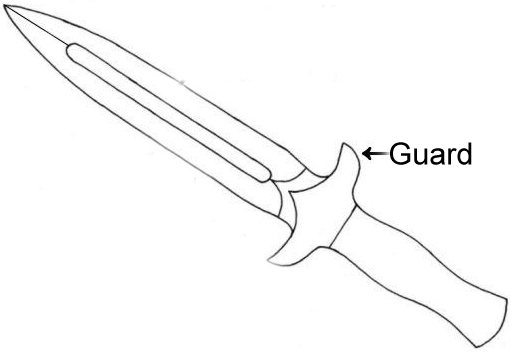
Let’s talk Marine whispering. Once I was told this reverse-grip-only tip by a civilian who had never been in the Marines, but heard this tip from the ubiquitous “Marine friend.” The irony was at the time, 1990s, I was in a Triangle, VA. hotel restaurant next to the Marine base Quantico, where I was teaching Marines in their Hand to Hand combatives, “Train the trainers” school, teaching “knife,” among other topics. Some of it was saber grip knife, some reverse grip. They didn’t care what grip we did. They were fully open to both. (Quick note: old school military holds that “hand-to-hand” training does not fully mean unarmed, it refers to close-up fighting, with or without weapons.)
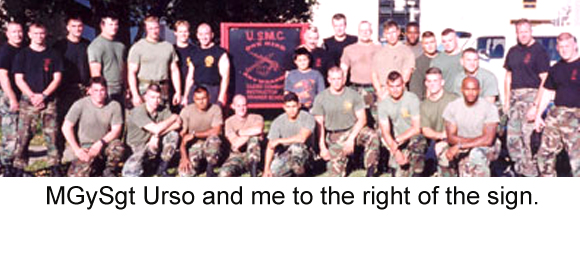
While in the Middle East or “Southwest Asia” as they like to call it, while in several PXs (military stores), I saw walls of all kinds of fixed blade or folder knives for sale. It seems everyone smartly has all kinds of issued or purchased knives, carried all over their bodies and who knows how they hold them. Fortunately about 99.9% of the time they are used for chores. A rare, rare few get any knife training. Some a small bit.
Some military units around the world like to watch-spy and imitate each other, and sometimes this jump innocently does replicate faults. In the mid-to-late 2010s and 2020s, some worldly units started copying other units by spending copious amounts of money buying vests, sheaths for knife carry in or near the center of the chest, along with a knife that has a ring atop it to run one’s pointy finger through and draw. The double-edged knife and sheath come in different sizes. This set-up forces troops into a reverse grip, whether they like it or not. The center staging does allow for right or left handed access. (If the knife hung upside down with a solid sheath and minus the ring, one could draw right or left handed to a saber grip. Just saying. But too late now! $$$$)
The Inside-Edge Only, Miasma. And on this subject, I will go you one more crazy level with a reverse grip oddity that’s worse. There is a small, knife sub-culture out there that wants you to fight reverse grip, with a single edge knife, and with the one sharp side, “inside,” as in facing back into your body. Not edge-out to the outside world where the enemy is attacking you. The edge is aimed back at you, Dull side, flat edge out facing the enemy. This is its own unique thinking disorder. The world you are fighting is OUT there, not in your armpit. This is essentially a one-trick pony.
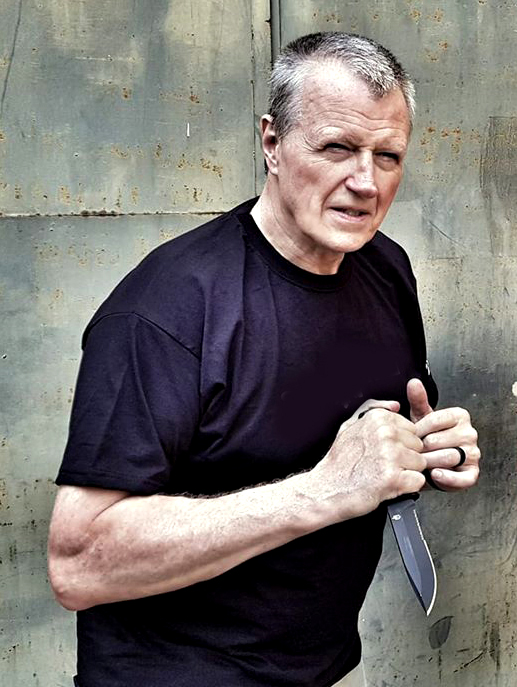
Reverse grip tip in accidents. When the Samurai commit suicide – seppuku – they do it with a reverse grip. There’s a reason for this. It’s easier. The tip is already aimed inward at you. (Incidentally, the helper that will kill him if he fails? Holds a saber grip.) This “easy-tip-inward” is one more point no one seems to consider when raving about reverse grips. The tip is often aimed back at you. About once every 4 weeks on the nightly reruns of the “Cops” TV show you can see a reverse grip knifer get tackled by cops. When they turn the suspect over? He or she was – “self-stabbed” in the grapple. One of our main lesson plans with the reverse grip is self-awareness of these maneuvering and grappling realities.
I cover dropping to the ground and we see people stab their thighs, and when tackled or shoved against the wall, we see the same “Cops” incident of the accidental self-stabbing. Tell people to practice falling-rolling while holding a reverse grip knife and watch the accidents. If people are running and holding a reverse grip knife, and they trip and fall? Watch out! There are more reverse grip “selfie” accidents than saber grip ones. Just be aware of this.
“Years ago I was grappling with my training partner and had a wooden training knife in the reverse grip. Long story short, we went to the ground and I fell on the training knife and caught the tip in the ribs. That definitely made my eyes water. Since then I’m very iffy whether I’d ever use that grip with a live blade in a real situation. I still train both grips but I much prefer the saber grip due to the added reach, maneuverability, and the sharp end isn’t pointing back at me most of the time.” – Neil Ferguson, USA
A Summary. I think by now we might have dispelled the caustic “Reverse Grip Marine Whisperer.” Still, there are many pros and cons for each grip. I HAVE MUCH TO SAY FOR THE REVERSE GRIP. I teach it also and I believe better and more comprehensive and thoughtful than most others…or I wouldn’t bother. I just don’t like the blind acceptance, the secret whisper about which grip is the best and which is to be mandated and or ignored. And It bothers me that people thoughtlessly accept courses about these main things. Question everything. Get educated with both. Then pick a knife and a grip you need in situations. I even hate to tell you my favorites because I don’t want to influence yours.
The knife is a very forgiving weapon, in that you can do a whole lot of screwed-up, stupid shit with a knife and it will work. This is not an excuse to stay stupid. You have to think beyond that to create a comprehensive program and promote real knowledge.
I can’t shake the fact that people essentially eat with a saber grip and most may well reflexively grab and use any knife in this manner. Look, I really don’t care what grip you use as long as it is an EDUCATED, informed choice, and not some mindless, mandate from some thinking disorder and, or brainwashed person, or from that ignorant knife whisperer who knows somebody, who knew somebody else, who…
Having written my extensive and popular knife book, which took years, studying crime, war and forensic medicine, working cases and the streets, I am an equal opportunity stabber. And I will only leave you with what Dan Inosanto said decades ago, – “there is no one perfect knife grip, just the best one for the moment.”
*****
Hock’s email is Hock@hockscqc.com
Play it again Sam…
“You must remember this.
A stick is just a stick.
A stick is not a sword.
The fundamental things in FMA, changed as time….goes….by…”
Filipino stick training. Filipino martial arts. When it comes to the FMA stick, it’s kind of schizophrenic. As usual I write about things as they “come up.” And last weekend’s seminar was another example of the routine question I hear once in a while – “Hock, I study Escrima, and the instructor told me you can’t grab the other’s guy’s stick because it’s supposed to be a bolo.” (Bolo being FMA for the sword or machete)
“Yeees,” I say. “True,” I say. “But what we have here today is…just a stick.”
The fact that this question continuously pops up, is reason alone to write about it. A Filipino stylist should know about this sword/stick thing and be able to explain and articulate on the subject. A stick is a sword? A sword is a stick? Not really. Can’t grab? Shouldn’t grab? As a person doing Arnis/Kali/Escrima since 1986 as an obsession at first, and now as a curious hobby of sorts, let me sketch this out for you.
There are MANY Filipino systems, way more than you have heard of. We just know the lucky-break ones. And systems are being invented all the time. In most of these old and new systems, practitioners have replaced the “wooden” (rattan) stick for the machete, sword as a safer training device. This replacement causes the confusion.
Do Filipinos carry sticks around? No. I’ve been to the Philippines several times, in some big cities and out in the provinces like the Negros Islands and whether it be the municipal areas or the isolated jungles, no one is walking around with a rattan stick on their belts. Plenty of machetes though. Plenty of sharp knives and sharp farm tools. No sticks. In the Philippines, or say, in Mexico and just about any farming culture locations anywhere really, if you are to be killed with an edged weapon, it will probably be a nasty old, rusty farm tool. In Mexico I am told, the expression is, “you will be killed by the $5 knife.”
Remy Presas would tell me stories of his youth and how he watched men with crop machetes fight and die for sport and money on the Negros. But there was a safer way to do this! And they used the round stick instead, which Remy Presas did for money also. So, a sporting/betting alternative to the machete was born. The stick! (And by the way they did have dulled “training machetes” to use also, but the round stick caught on better. Oh, the lucky breaks.)
I guess for some I should introduce or remind folks the difference between a round stick and a flat sword/machete. You see, one is round. One is flat. There ya go! But really, they swing different, weigh different and if you are limited to flat edges, one should really be applied differently. A stick is an impact weapon that strikes with the tip, the staff of it, and the handle.
On the subject of the stick and sword handle – the sword handle can be round so to speak, but often very contoured and form-fighting for the hand. While the Filipino stick is usually just round with no designated end for an official handle. In fact it might be a little taboo to have a designated handle on your FMA stick? We sometimes grimace a bit when we see an over-taped or customized baston handle, don’t we? While FMA swords have all kinds of admirable, customized grips. And proud of it, too.
Many of the machetes around the world are single edge, and the swords are not necessarily single edged, and can come in all kinds of interesting and elegant shapes, but FMA swords usually that not big and wide like…like say, European broadswords. (Please do not send me photos of giant, Filipino broadswords – I know they exist – I used the word “usually.”) But with the “roundness” of a stick, you lose the very vital, flat-edge-ness of the sword. Oh yeah, and swords are more deadly, faster finishers and need less power application than sticks.
To accept the stick hand grab is too ignore sword tradition and perhaps believe that in our next street fight, we would be stick-dueling with some thug? The designated thug will use the exact same-sized, designated stick we have! Then again, will you be sword or machete dueling? Outside of a few big “civilized” countries? Well…yes.
Somehow the sword shape-shifted into the stick so deep in our hearts and minds. Oh, for the love of sticks! For decades, the FMA lover just used sticks, stick, STICKS! The art, the tricks of STICK fighting, stick-centricm alone developed. Many lovers do not know, or do not care that the sticks are supposed to be swords and machetes. And with the stick, comes a lot of double-hand grabbing and opponent stick grabbing. Look at Tapi-Tapi and Balintawak, for just two pop examples. We all accept the rules that sticks are sticks, sticks have become embraced in FMA and by God, we’ll grab them whenever and where ever we want.
So, in the 1990s stick enthusiasts came out of the traditional closest and started declaring “you must remember this, a stick is just a stick, a sigh is just a sigh. The fundamental things of living, as time goes by.” And I agree! Just understand you are using a stick. The round stick acceptance was easier for me perhaps because, being a cop, I always thought of the rattan baston as a police stick (or an axe handle). My interest in the FMA stick was not an esoteric, artsy pursuit. People are not “Kung Fu fightin’ – fast as lightning” with matching 28-inch sticks in the alleyways of London (I hear they are throwing a lot of acid these days) or on the south side of Chicago. I wanted to know stick/baton stuff.
Then, I somehow eased into decades of fun, hobby, certainly social, Filipino stick fighting/dueling stuff. I actually run TWO kinds of stick courses. One, the main big one is Force Necessary: Stick which explores blocking, striking and grappling with an modern impact versus hands, sticks, knives and gun threats. There is zero implication that this is based on any swords. And if you want me to? Ask me to? I will do the Filipino stick vs stick materials I have learned since 1986. Granted I have cut that down too. I play stick-checkers not stick-chess, seeking the essence of it all and not mindlessly, endlessly replicating established – and often BLOATED systems. Or while away my time, seeking out the next stick system, and oh the fascinating magic that THEY do. I don’t run a stick museum, and hell…it’s just a damn stick. (As Remy would often say – “of course, you could just hit the man in the head with the stick.”)
Isn’t it odd that a round stick is chosen to replace a flat bolo or sword? That is like replacing a flat katana with a round broom stick. Isn’t it? katana practitioners would never accept that.
So we learned that legions of FMA-ers picked up their rounded sticks, sewed on their Filipino patches in revolution and clickety-clicked onward. As though machetes and thin swords never existed. It really is amazing how many FMA-ers blindly accepted the rattan stick as the real-deal McCoy when you think of it. I mean what would Japanese Katana fanatics think of waves of people using broom sticks and calling themselves Katana experts? Would golfers use hockey sticks? Would Chinese fan fighters use tennis rackets? Would a carpenter use a file instead of a saw? Thus the odd, FMS Stick, schizophrenia I suggested.
Everyone seems so happy with their sticks and stick bags. But still, you can hear these darn spoil sports complain that you should not and cannot grab your stick with two hands, nor can you grab your opponent’s stick with your free hand because it’s a sword! You fool! How dare you! It’s a sword! A bolo! A machete!
The stick is just like the sword? Is this an excuse? That the universality of FMA weaponry makes them ever so interchangeable? Swords, sticks. Hands. Thin lamps. Rolling pins? “Who throws a shoe, honestly?” I don’t know because while some elements are the same, there are differences bigger than mere nuance. A sword…is kinda’…just like a sword.
In the last few years I have noticed an increase in…Filipino sword fighting! Yes. Haven’t you seen it? Hundreds of FMA folks have picked up the thin sword. FMA sword grandmasters have arisen from the ashes. I applaud their interest and their understanding that the whole FMA shebang really comes from swords and machetes. My old friends like Chris LaCava and Christof Froehlich, just to name a few, have jumped deep into the roots, understanding the big picture.
And listen up you “grab-complainer instructors!” If you are so damned offended by people grabbing sticks and forgetting the stick is a machete? Look what’s in your hand! Look what YOU teach with! PUT DOWN THE DAMN STICK AND PICK UP A TRAINING SWORD INSTEAD! That will straighten things out. You know, you can buy dull, safe training swords and plastic swords and machetes too. You are NOT limited to the round “wooden” stick as an abstract facsimile. If you are going have hissy-fits about it? Then practice what you preach and use a damn sword! Pick a theme! A direction! Seriously! If you think the stick is a sword? Don;t confuse your people. Just use a training sword.
If you use a stick? It’s a stick. Grab it.
So, play it again Sam…
“You must remember this.
A stick is just a stick.
A stick is not a sword.
The fundamental things in FMA, changed as time….goes….by…”
+++++++
Hock’s email is HockHochheim@ForceNecessary.com
Strike! Thwart! Thwarted! the Single Stick 35 Essentials. Get this DVD or Download
When was this? This big, “Filipino martial arts turning point” for me? Keep in mind, this is just me and my personal view on things. Don’t hate me cuz I’m viewtiful!
I started doing FMA in 1986, in among other arts like JKD, and had been doing the classic karate and jujitsu (not the Brazilian wrestling version of today). By about 1993 I had covered a lot of FMA material, been to the Philippines twice. Got black belts from both Ernesto Presas and Remy Presas.
The big turning point came with double sticks, of all odd, obscure things. In 1993, a friend called me and said, “Hey Hock, this weekend, Guro ______ is coming into Dallas! He is going to do two full days of the ______ double stick drills. Are you coming?”
Two full days of…double sticks? I guess this phone call had an epiphany moment for me when several ideas flashed through my head. I found myself confessing…
“Two days? Double sticks? Well, I think I’ll pass. I mean, how many double stick drills are there anyway?”
“You’re gonna miss it! A chance to learn THEE _______ double stick drills!”
When we hung up, I examined my epiphany moment. Well, from the Inosanto world, the Remy Presas world, and Ernesto Presas world, I’d already collected about 50 double stick drills according to my anal retentive lists I keep. FIFTY ! I suddenly asked myself,
How ARE they the same? I realized that it was more important to organize the drills, not from the hero-worship-“who” or the hero worship-“what” fan club systems, but instead how are the drills all the same? (It is counter productive and stifling to worship system-heads and systems.)
How are they so similar. And how and why am I wasting my time collecting endless double stick drills from a nearly endless group of known and unknown system-heads who all think theirs are ever-so-special. Many of which are so much the same and with only one slight different tweak here or there. Rather, smarter, I should instead try to understand the essence of all of them. The essential core. Then, teach the universal core.
I was already contemplating the differences between the Remy and Ernesto double stick programs. Remy seemed to have 5 or 6 basic patterns with variations. Ernesto had the classic “must know” list.
Then…then I asked myself why I didn’t view ALL aspects of the varied FMAs the same way? Why not find the universal core of FMA itself? Find the very of essence…
…in this clean, kind of scientific manner? Study these cores first. Deal with the needed and dismiss the probably unneeded and-or redundant and-or prissy variables.
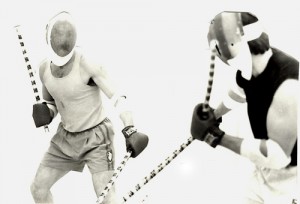
There will always be happy museum and happy history collectors, who collect ANYTHING from ANYBODY. And then those who like to sort-of, name-drop stuff like – “at this point, Roohan moved his kneecap this way, while Roohan kept his meniscus right here…” I can talk some of that artsy smack too, just from training years osmosis. I can delight the esoteric fanatics with these tidbits of meniscus positioning. I can also tell you that Ed Kranepool played first base for the Mets in the 1960s. Hey! I do know stuff! But how useful is it?)
Annnnd with that idea? I started constructing the generic PAC course. Pacific Archipelago Concepts, an irreverent, skeptical look at the related core of those related arts. This includes all the big systems in the Pacific Ocean. A lot of this work had been done, like with Kajukenbo (karate, jujitsu, kenpo, boxing).
This clean, generic, non-worship approach did not make me popular with some existing FMA entities, (some are cult-like) in fact I was suddenly shunned by some. And in the seminar business, it is still not my most popular or even my favorite course to teach, as I usually cover generic “combatives” for lack of a better term. But hey, FMA is fun to do, good exercise, a hobby with numerous abstract mental and physical benefits. And when asked to, I will happily cover it. I feel like if I can spread the core-foundation. Then anyone can more quickly blend into any FMA system they wish to pursue.
(By the way, I carried this “core” perspective over to combatives. In a way, this “double stick epiphany” in 1993 was an important idea in more ways than one. It gave me a mission. A purpose. A vision if you will. My pursuit, my study, my interest, my goal, is the universal generic.)
Back to 1993! I later asked that friend back in 1993,
“How was the _______ double stick seminar?”
“It was great!” he said, “We did 30 drills. Most of them we already do, others just a little different here and there.”
Already do? Imagine that!
********
Hock’s email is hock@hockscqc.com
Get the full info on the PAC-FMA course right here, click here